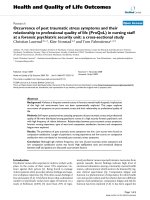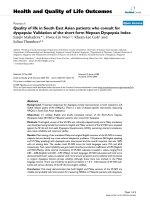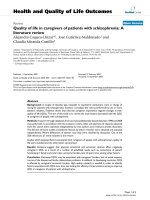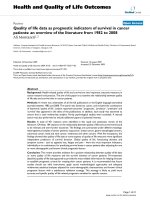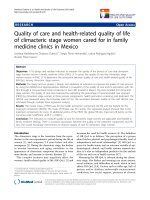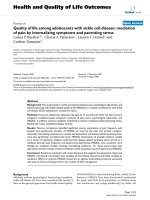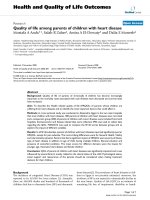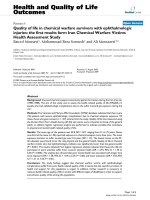Báo cáo hóa học: " Quality of life in children three and nine months after discharge from a paediatric intensive care unit: a prospective cohort study" pdf
Bạn đang xem bản rút gọn của tài liệu. Xem và tải ngay bản đầy đủ của tài liệu tại đây (292.02 KB, 9 trang )
BioMed Central
Page 1 of 9
(page number not for citation purposes)
Health and Quality of Life Outcomes
Open Access
Research
Quality of life in children three and nine months after discharge
from a paediatric intensive care unit: a prospective cohort study
Hendrika Knoester*
1
, Madelon B Bronner
2
, Albert P Bos
1
and
Martha A Grootenhuis
2
Address:
1
Paediatric Intensive Care Unit, Emma Children's Hospital, Academic Medical Centre, Meibergdreef 9, 1105 AZ Amsterdam, The
Netherlands and
2
Psychosocial Department, Emma Children's Hospital, Academic Medical Centre, Meibergdreef 9, 1105 AZ Amsterdam, The
Netherlands
Email: Hendrika Knoester* - ; Madelon B Bronner - ; Albert P Bos - ;
Martha A Grootenhuis -
* Corresponding author
Abstract
Background: Improved survival in children with critical illnesses has led to new disease patterns.
As a consequence evaluation of the well being of survivors of Pediatric Intensive Care Units (PICU)
has become important. Outcome assessment should therefore consist of evaluation of morbidity,
functional health and Health Related Quality of Life (HRQoL). Awareness of HRQoL consequences
and physical sequelae could lead to changes in support during the acute phase and thereafter. The
aim of this study was to evaluate HRQoL in PICU survivors.
Methods: Prospective follow-up study three and nine months after discharge from a 14-bed
tertiary PICU. Eighty-one of 142 eligible, previously healthy children were included from December
2002 through October 2005. HRQoL was assessed with the TNO-AZL Preschool Children Quality
of Life Questionnaire (TAPQOL-PF) for children aged 1 to 6 years of age, the TNO-AZL Children's
Quality of Life Questionnaire Parent Form (TACQOL-PF) for children aged 6 to 12 years of age,
and the TNO-AZL Children's Quality of Life Questionnaire Child Form (TACQOL-CF) for
children aged 8 to 15 years of age. The studied patients were compared with age appropriate
normative data using non-parametric tests and effect sizes.
Results: Thirty-one and 27 children, and 55 and 50 parents completed questionnaires respectively
three and nine months after discharge. In 1–6 year old children parents reported more lung
problems (3 and 9 months), worse liveliness (9 months) and better appetite and problem behaviour
(3 months); in 6–12 year old children parents reported worse motor functioning (3 months); and
12–15 year old adolescents reported worse motor functioning (3 months). Large effect sizes
indicating clinical significant differences in HRQoL with healthy control subjects were found on
more domains.
Conclusion: In this small group of PICU survivors differences in HRQoL with the normative
population exist three and nine months after discharge. Calculated effect sizes were smaller nine
months after discharge. These changes suggest that HRQoL improves over time. More research is
necessary but we believe that HRQoL assessment should be incorporated in follow-up programs
of PICU survivors.
Published: 11 March 2008
Health and Quality of Life Outcomes 2008, 6:21 doi:10.1186/1477-7525-6-21
Received: 9 July 2007
Accepted: 11 March 2008
This article is available from: />© 2008 Knoester et al; licensee BioMed Central Ltd.
This is an Open Access article distributed under the terms of the Creative Commons Attribution License ( />),
which permits unrestricted use, distribution, and reproduction in any medium, provided the original work is properly cited.
Health and Quality of Life Outcomes 2008, 6:21 />Page 2 of 9
(page number not for citation purposes)
Background
The development of paediatric intensive care units
(PICU's) has contributed to improved survival in children
with critical illnesses. [1,2] As a consequence of improved
survival new disease patterns evolved, such as growth dis-
turbances of limbs after meningococcal disease. [3,4] Out-
come assessment should therefore consist of evaluation of
morbidity and well being. Functional health and Health
Related Quality of Life (HRQoL) are used as outcome
measures to evaluate patient's well being. In 1948, the
World Health Organization defined health as 'a state of
complete physical, mental and social well-being, and not
merely the absence of disease or infirmity'. Functional
health is defined as an individual's ability to perform nor-
mal daily activities, essential in order to meet basic needs,
to fulfill usual roles, and to maintain health and well-
being. [5]Quality of life (QoL) is defined as an individual's
perception of their position in life, in the context of the
culture and value systems in which they live, and in rela-
tion to their goals, expectations, standards and concerns.
[5] HRQoL is defined as QoL in which a dimension of per-
sonal judgement over one's health and disease is added.
[6] In case of children, HRQoL is influenced also by fac-
tors such as the ability to participate in peer groups and
the ability to keep up with developmental activities. Sev-
eral difficulties lie in measuring QoL in children, includ-
ing (1) lack of consensus on suitable instruments, (2) the
need for different instruments in different age groups and
(3) the need of proxy reporting by parents or clinicians in
children younger than 8 years of age. [7-11]
Although physical and psychological sequelae have been
described, studies focusing on HRQoL in PICU survivors
are scarce. [12-17] The Health Utilities Index (HUI) 2 is
used in five studies to evaluate functional health. In three
studies ± 30% of PICU survivors were in full health, one
year after discharge. [18-20] In the Australian and Swiss
studies using the HUI 2, ± 80% of the survivors were
scored as having good quality of life one year after PICU
discharge. [21,22] The HUI 2 evaluates only six domains
of HRQoL: sensation, mobility, emotion, cognition, self-
care and pain. Evaluation is done by the parents and not
the children themselves when older than eight years of
age. In another Australian study the Royal Alexandra Hos-
pital for Children (RAHC) Measure of Function-Clinical
Rating Scale was used to evaluate QoL: 60% of survivors
had normal QoL, 3 to 24 months after discharge. [23]
Evaluation is done by the primary physician. In all studies
loss of follow-up is substantial and selection bias is possi-
ble. No studies exist, evaluating changes over time in
HRQoL.
The aim of our study was to evaluate HRQoL in previously
healthy children that were unexpectedly admitted to the
PICU at two time points (three and nine months) after
discharge and to evaluate whether HRQoL changes over
time. Evaluation was done at the out-patient follow-up
clinic by validated questionnaires completed by parents of
children younger than 8 years of age and by children
themselves when 8 years of age or older. We hypothesized
that HRQoL is decreased after PICU discharge and
improves over time.
Methods
This study was part of an on-going explorative research
program on physical and psychological sequelae and con-
sequences for QoL in children and their parents after an
acute and unexpected PICU admission. The PICU of the
Emma Children's Hospital/Academic Medical Center
Amsterdam is a tertiary PICU with 14 beds admitting
patients from the greater Amsterdam area. Medical, surgi-
cal and trauma patients and patients from all pediatric
subspecialties are admitted.
In this study we only wanted to include previously healthy
children that were unexpectedly admitted to the PICU
with a serious illness, for instance respiratory and circula-
tory insufficiency due to respiratory syncitial virus (RSV)
infection or meningococcal disease, and all trauma
patients. Furthermore children admitted for respiratory
insufficiency necessitating ventilatory support for at least
24 hours and children admitted to the PICU for at least 7
days were included. We excluded children with known
underlying illnesses or patients with scheduled elective
surgery; admission due to abuse or self-intoxication and
the inability to complete Dutch questionnaires because of
a language barrier. The study was done from December
2002 through October 2005.
After discharge from the PICU, each family received a let-
ter explaining the aim and content of the research pro-
gram. Families were contacted by telephone to enhance
participation. For cases lacking telephone contact, follow-
up letters with tear-off reply slips inviting participation
were sent. Written informed consent was obtained from
all participating families. The Medical Ethic Committee of
the Academic Medical Centre in Amsterdam has approved
the study protocol.
Three and nine months after discharge QoL question-
naires were sent to all families with a reply envelope. All
families were invited to visit the outpatient follow-up
clinic three months after discharge for structured medical
and psychological examination of the child by a pediatric
intensivist and a psychologist.
Health related quality of life questionnaires
HRQoL was assessed with the TNO-AZL Preschool Chil-
dren Quality of Life Questionnaire (TAPQOL-PF) for chil-
dren aged 1 to 6 years of age, the TNO-AZL Children's
Health and Quality of Life Outcomes 2008, 6:21 />Page 3 of 9
(page number not for citation purposes)
Quality of Life Questionnaire Parent Form (TACQOL-PF)
for children aged 6 to 12 years of age, and the TNO-AZL
Children's Quality of Life Questionnaire Child Form
(TACQOL-CF) for children aged 8 to 15 years of age. [24-
31] These questionnaires are generic Dutch instruments
that measure health status problems weighted by the
impact of the health status problems on well being. It
offers the respondent the possibility of differentiating
between their functioning and the way they feel about it.
Most of the items consist of two questions linked to
another. On the first one, the respondent can rate on a
three point scale, (never, occasionally, or often), whether
or not a specific problem occurred in the past few weeks.
If a problem occurred, the child can indicate how it felt
about this problem on a four point Likert scale: (very)
good (3) – not so well (2) – rather bad (1) – bad (0).
Numbers between brackets refer to the values resulting in
the HRQoL scores. (Figure 1) The items are clustered into
multi-item scales; scale scores are calculated by adding up
item scores within scales, with higher scores indicating
better QoL. For the TAPQOL-PF crude scales scores are
transformed linearly to a 0–100 scale; for the TACQOL-PF
and TACQOL-CF maximum domain scores are 16 for the
emotional scales and 32 for the other scales. In the calcu-
lation of the scale scores one or two missing combined-
item scores are allowed for. They are replaced by the mean
value of the non-missing (combined) item scores. For
respondents with more missing combined item scores per
scale, the scale is assumed to be missing. Normative data
from the general Dutch population are available. The
instruments measure HRQoL on a group level in a reliable
and valid way. Reliability (Cronbach's alpha) in the gen-
eral populations are moderate to good (0.59–0.84) for all
scales in all questionnaires, except for 'stomach function-
ing' and 'motor functioning' in the TAPQOL-PF. Criterion
validity is good for all scales in all questionnaires, demon-
strating that the scales can detect differences between
healthy and less healthy children. [27,30,31] The studied
patients were compared with age appropriate normative
data using non-parametric tests and effects sizes.
The TAPQOL-PF assesses the child's functioning on 43
items in 12 domains: sleeping, appetite, lungs, stomach,
skin, motor functioning, liveliness (together physical
functioning), problem behavior, anxiety, positive mood
(together emotional functioning), communication (cog-
nitive functioning), and social functioning. Scales that
measure motor functioning, social functioning and com-
munication are applicable only to children 1.5 years and
older.
The TACQOL-PF and TACQOL-CF assess functioning on
seven domains: physical complaints, motor functioning,
autonomy, cognitive functioning, social functioning (in
relation to peers), positive and negative emotional func-
tioning. Scale structure and reliability proved less satisfac-
tory for the children between 12–15 years of age.
Therefore some items from the original social scale were
removed and the autonomy scale was removed in its total-
ity. [31]
Patient characteristics were obtained from medical
records and the Patient Data Management System.
Statistics
Data analysis was done with the Statistical Package for
Social Sciences (SPSS), Windows version 11.5. Before con-
ducting the final analyses several preparation analyses
were conducted: (1) Scales were constructed and missing
data imputed on the basis of the guidelines of the ques-
tionnaires used; (2) descriptive statistics (Mann-Whitney
and Chi-square tests) were used to describe the patient
characteristics of the participants and non-participants;
(3) non-parametric tests, (one sample sign-test or bino-
mial test if median was equal to maximum), were per-
formed to test whether the median or the binomial
distribution of the several HRQoL-scales scores of the
patients differed from the normative data available; (4)
effect sizes (d) were calculated by dividing the difference
in mean scores between the patients and the normative
group by the standard deviation of the scores in the nor-
mative group. According to Cohen, effect sizes of about
0.2 were considered to be small, effect sizes of about 0.5
to be moderate, and effect sizes of about 0.8 to be large
[32]; (5) all above mentioned analyses were performed
for the whole group of participants (completed question-
Example of question in HRQoL questionnaireFigure 1
Example of question in HRQoL questionnaire. Numbers between brackets refer to the values resulting in the HRQoL
scores.
+DV\RXUFKLOGKDG ƑQHYHU ƑRFFDVLRQDOO\ƑRIWHQ
HDUDFKHVRUVRUHWKURDWV"
$WWKDWWLPHP\FKLOGIHOW
ƑILQH ƑQRWVRJRRG ƑTXLWHEDG ƑEDG
Health and Quality of Life Outcomes 2008, 6:21 />Page 4 of 9
(page number not for citation purposes)
naires 3 and/or 9 months after discharge); (6) paired t-
tests were performed for the group that completed both
questionnaires, to test for differences over time. A signifi-
cance level of p < 0.005 was used in all tests to compensate
for multiple testing.
Patients' self-reports were used for analysis unless the self-
report was not available due to the young age of the
patient. Separate analyses were conducted for (1) patients
aged 1–5 years, using the TAPQOL-PF, (2) patients aged
6–11 years, using the TACQOL-PF, (3) patients aged 8–11
years, using the TACQOL-CF for children, and (4) patients
aged 12–15 years, using the TACQOL-CF for adolescents.
We decided to report all age groups despite small num-
bers, because the results in the different age groups were
comparable.
Results
Participants
A total of 142 patients were eligible for participation in
this part of the study. Twenty-seven refused participation
(for geographical reasons or no interest), 12 said that they
would like to participate but never returned their ques-
tionnaires or did not complete the full questionnaire; 22
families did not respond at all. Of 81 children either the
children or their parents completed one or both question-
naires. The response rate is 57%. Thirty-one and 27 chil-
dren completed questionnaires respectively three and
nine months after discharge; 55 and 50 parents completed
questionnaires respectively three and nine months after
discharge. Twenty-three children and 36 parents com-
pleted questionnaires at both moments. (Figure 2) Statis-
tically significant differences were found between
participants and non-participants with respect to length of
stay in the PICU. Fourteen participants and no non-partic-
ipants had lengths of stay in the PICU of longer than 21
days. (Table 1).
TAPQOL-PF 1–6 years of age
Thirty-four and 33 of 75 eligible parents completed the
TAPQOL-PF respectively three and nine months after dis-
charge, 22 of these parents completed the TAPQOL-PF at
both moments. The response rate in this group is 45% at
three months and 44% at nine months. Statistically signif-
icant differences between the PICU survivors and healthy
control subjects were found on three domains (more lung
problems, better appetite and better problem behaviour)
three months after discharge and on two domains (more
lung problems, worse liveliness) nine months after dis-
charge. Large effect sizes were found on three domains
nine months after discharge: indicating worse HRQoL on
motor functioning, positive mood and liveliness. (Table
2)
Participants and non-participantsFigure 2
Participants and non-participants. Numbers of participants that completed the different questionnaires at 3 and 9 months
after discharge and numbers of non-participants.
Eligible for follow-up study 142 patients
Non-participants 61 patients
Refused participation 27
Did nor return (complete) questionnaire 12
No respons 22
Participants 81 patients
1-6 years questionnaires returned
TAPQOL 3 months after discharge 34
TAPQOL 9 months after discharge 33
TAPQOL 3 and 9 months after discharge 22
6-11 years questionnaires returned
TACQOL-PF 3 months after discharge 21
TACQOL-PF 9 months after discharge 17
TACQOL-PF 3 and 9 months after discharge 14
8-11 years questionnaires returned
TACQOL-CF 3 months after discharge 16
TACQOL-CF 9 months after discharge 13
TACQOL-CF 3 and 9 months after discharge 11
12-16 years questionnaires returned
TACQOL-CF 3 months after discharge 15
TACQOL-CF 9 months after discharge 14
TACQOL-CF 3 and 9 months after discharge 12
Health and Quality of Life Outcomes 2008, 6:21 />Page 5 of 9
(page number not for citation purposes)
TACQOL-PF 6–12 years of age
Twenty-one and 17 of 38 eligible parents completed the
TACQOL-PF respectively three and nine months after dis-
charge; 14 of these parents completed the TACQOL-PF at
both moments. The response rate in this group is 55% at
three months and 45% at nine months. Statistically signif-
icant differences between PICU survivors and healthy con-
trol subjects were found on one domain (motor
functioning) three months after discharge and on no
domains nine months after discharge. Large effect sizes
were found on four domains (indicating worse HRQoL on
physical functioning, motor functioning, autonomy, and
social functioning) three months after discharge and on
one domain (indicating worse HRQoL on motor func-
tioning) nine months after discharge. (Table 3)
TACQOL-CF 8–12 years of age
Sixteen and 13 of 29 eligible children completed the TAC-
QOL-CF respectively three and nine months after dis-
charge; 11 of these children completed the TACQOL-CF at
both moments. The response rate in this group is 55% at
three months and 45% at nine months. No statistically
significant differences between PICU survivors and
healthy control subjects were found three and nine
months after discharge. No large effect sizes were found
three and nine months after discharge. (Table 4)
TACQOL-CF 12–16 years of age
Fifteen and 14 of 38 eligible adolescents completed the
TACQOL-CF respectively three or nine months after dis-
charge; 12 of these adolescents completed the TACQOL-
CF at both moments. The response rate in this group is
40% at three months and 37% at nine months. Statisti-
cally significant differences between PICU survivors and
healthy control subjects were found on one domain
(motor functioning) three months after discharge and on
no domains nine months after discharge. Large effect sizes
were found on one domain three and nine months after
discharge: indicating worse HRQoL on motor function-
ing. (Table 5)
Differences over time
In the parents and children that completed both question-
naires, no statistically significant differences were found
over time, indicating that HRQoL did not change from
three to nine months after discharge.
Table 2: TAPQOL-PF. Mean HRQoL scores for children aged 1 to 6 years of age that completed one or both questionnaires (mean ±
sd)
3 months after discharge
(n = 34)
Effect size (d) P Value 9 months after discharge
(n = 33)
Effect size (d) P Value Normative data
Stomach problems 91.9 ± 12.0 0.00 0.2 89.1 ± 15.8 0.3 0.2 91.9 ± 13.8
Skin problems 93.9 ± 8.9 0.2 0.3 91.9 ± 11.1 0.009 0.7 91.8 ± 10.8
Lung problems 83.8 ± 18.4* 0.6 0.000 85.9 ± 21.7* 0.5 0.002 93.6 ± 16.2
Sleeping 73.9 ± 21.1 0.5 0.03 78.5 ± 20.3 0.2 0.4 82.3 ± 17.3
Appetite 89.8 ± 10.0* 0.4 0.004 84.1 ± 15.5 0.04 0.08 84.6 ± 13.2
Motor functioning 95.7 ± 8.0 0.6 0.02 92.4 ± 15.4 1.4 0.007 98.5 ± 4.4
Social functioning 93.2 ± 15.1 0.1 0.2 88.7 ± 17.0 0.2 0.3 91.3 ± 15.4
Problem behaviour 76.6 ± 16.0* 0.6 0.004 73.4 ± 18.2 0.4 0.6 67.7 ± 15.3
Communication 90.8 ± 12.0 0.1 1.0 90.8 ± 13.4 0.1 0.6 91.7 ± 9.9
Anxiety 72.2 ± 21.5 0.3 0.5 79.6 ± 21.4 0.1 0.3 78.3 ± 18.0
Positive mood 97.4 ± 9.6 0.2 0.2 93.4 ± 16.6 0.8 0.01 98.7 ± 6.5
Liveliness 92.9 ± 16.2 0.6 0.03 90.6 ± 17.9* 0.9 0.002 98 ± 8.0
* p < 0.005 whole group versus normative data.
High scores represent a better HRQoL
Table 1: Patient characteristics of participants and non-
participants
Participants
n = 81
Non-participants
n = 61
Median (range) Median (range)
Age of child at PICU
admission(yrs)
5.8 (1–14.9) 4.9 (1–14.8)
Length of stay in PICU (days) 5.0 (1–305)* 2.0 (1–31)
Length of artificial ventilation
(days)
4.0 (0–43) 2.0 (0–26)
Risk of Mortality, PIM 2 (%) 4.4 (0–32.4) 3.8 (0–80.5)
n (%) n (%)
Male 44 (54) 36 (59)
Reason for PICU admission
Respiratory insufficiency 34 (42) 31 (51)
Circulatory insufficiency 18 (22) 12 (20)
Trauma 29 (36) 18 (29)
Treatment characteristics (yes)
Artificial ventilation 62 (76) 45 (74)
Circulatory support 22(27) 12 (20)
* p < 0.05 participants versus non-participants
Health and Quality of Life Outcomes 2008, 6:21 />Page 6 of 9
(page number not for citation purposes)
Discussion
This is one of the first studies to describe HRQoL of chil-
dren after a PICU experience using validated and reliable
instruments. In all age groups, except for 8–12 year old
children statistically significant differences with the nor-
mative population were found on a number of domains.
The parents of 1–6 year old children reported statistically
significant lower scores on lung problems and liveliness;
and statistically significant higher scores on emotional
domains like problem behaviour and appetite. The par-
ents of 6–12 year old children and the 12–15 year old
children scored statistically significant lower on motor
functioning. In the children and parents that completed
questionnaires three and nine months after discharge no
statistically significant differences were found over time.
However, almost all differences with the healthy Dutch
population disappeared after nine months, except for
worse motor functioning in almost all age groups and
more lung problems, worse positive mood and worse live-
liness in 1–6 year old children.
Effect sizes (d) were calculated to assess the magnitude of
differences in mean scores between the patient sample
and the normative population. [32] In all evaluated
groups moderate and large effect sizes were found on
more HRQoL domains than statistically significant differ-
ences were found. At three months after discharge, effect
size calculation indicated worse HRQoL on physical,
social and emotional domains compared to the norma-
tive population. At nine months after discharge most
effect sizes decreased, indicating improvement of HRQoL,
except for motor functioning, positive mood and liveli-
ness in 1–6 year old children. Probably statistically signif-
icant differences were not found due to the small number
of evaluated patients in the different age groups. Despite
the lack of statistically significant differences, changes in
effect size suggest that several domains of HRQoL are
decreased at three months after discharge and improve
over time.
Studies focusing on QoL in PICU survivors are scarce. The
Health Utilities Index (HUI) 2 was used in 4 studies. [18-
21] In three of these studies 64% of the evaluated children
reported no affected domains one year after discharge.
[18,19,21] The HUI 2 is a questionnaire answered by the
physician and not the child itself or its parents; and it does
not measure all aspects of QoL. Mobility is the only phys-
ical aspect that is evaluated and social aspects, family
functioning, and well being are not evaluated. In a fifth
study the Royal Alexandra Hospital for Children (RAHC)
Table 4: TACQOL-CF 8–12. Mean HRQoL scores for children aged 8–12 years of age that completed one or both questionnaires
(mean ± sd)
3 months after discharge
(n = 16)
Effect size (d) P Value 9 months after discharge
(n = 13)
Effect size (d) P Value Normative data
Physical functioning 22.4 ± 6.0 0.5 0.2 25.2 ± 5.0 0.03 0.5 24.9 ± 5.1
Motor functioning 28.6 ± 3.1 0.3 0.1 29.8 ± 3.3 0.009 0.2 29.8 ± 3.2
Autonomy 30.9 ± 2.4 0.2 0.5 31.3 ± 1.6 0.05 0.5 31.2 ± 1.9
Cognitive functioning 27.9 ± 4.6 0.2 1.0 30.8 ± 1.9 0.6 1.0 28.4 ± 3.9
Social functioning 30.9 ± 1.9 0.4 1.0 29.8 ± 3.4 0.02 0.8 29.7 ± 2.8
Positive emotions 12.1 ± 3.2 0.6 0.5 12.7 ± 3.1 0.4 0.7 13.6 ± 2.5
Negative emotions 9.8 ± 2.9 0.7 0.007 12.8 ± 2.6 0.4 0.1 11.6 ± 2.7
* p < 0.005 whole group versus normative data.
High scores represent a better HRQoL
Table 3: TACQOL-PF. Mean HRQoL scores for children aged 6–12 years of age that completed one or both questionnaires (mean ±
sd)
3 months after discharge
(n = 21)
Effect size (d) P Value 9 months after discharge
(n = 17)
Effect size (d) P Value Normative data
Physical functioning 24.0 ± 4.7 0.8 0.02 25.9 ± 3.7 0.3 0.2 27.1 ± 4.0
Motor functioning 27.4 ± 4.6* 1.3 0.003 28.6 ± 5.4 0.8 0.05 30.8 ± 2.6
Autonomy 29.0 ± 4.2 1.3 0.01 31.1 ± 1.7 0.006 0.6 31.2 ± 1.7
Cognitive functioning 27.8 ± 4.8 0.3 0.8 27.4 ± 7.6 0.4 0.8 29.0 ± 3.8
Social functioning 27.9 ± 3.9 0.8 0.3 29.6 ± 3.4 0.1 0.4 29.9 ± 2.5
Positive emotions 13.9 ± 2.8 0.5 0.2 13.4 ± 3.5 0.7 0.5 14.8 ± 2.0
Negative emotions 10.1 ± 2.3 0.6 0.01 10.8 ± 3.3 0.3 0.6 11.5 ± 2.4
* p < 0.005 whole group versus normative data.
High scores represent a better HRQoL
Health and Quality of Life Outcomes 2008, 6:21 />Page 7 of 9
(page number not for citation purposes)
measure of function was used. [23] In this study results of
the telephone interviews of the physicians are reported.
Consensus on appropriate questionnaires to evaluate
HRQoL is essential. The ideal questionnaire should meas-
ure all aspects of QoL or HRQoL and if possible by the
child himself (≥ 6–8 years of age). Proxy investigation
(necessary if a child is <6–8 years of age) is second best
because proxy reports do not always correspond with self-
evaluations, depending on the health aspect being exam-
ined. For example, concordance for items and domains
concerning functional limitations are higher compared to
items and domains concerning emotional and social well
being. [9,28,33] Physicians are not the right persons to
answer QoL and HRQoL questionnaires of their patients.
[8,34]
In the young children for whom parents completed the
questionnaires, more statistically significant differences
and larger effect sizes are found on HRQoL domains than
in the older children that completed the questionnaires
themselves. This study was not designed to compare self
reporting and proxy reporting. In the 6–12 year old chil-
dren that were evaluated by their parents moderate to
large effect sizes were found in all domains except cogni-
tive functioning, three months after discharge. In the 8–12
year old children that completed the questionnaires them-
selves moderate effect sizes were only found in physical
functioning, and positive and negative emotional func-
tioning, three months after discharge. A possible reason
why parents report more problems, could be a different
appraisal of the severity of the situation and consequently
a different perception of HRQoL domains. It is imagina-
ble that pediatric children look less into the future than
their parents, and are less aware of the stressful situation
that has occurred. Older children are possibly more aware
what has happened, which leads to feelings of happiness
to have survived. [9,28,33]
In the 1–6 year old children the domains appetite and
problem behaviour are scored better than the normative
population. An explanation of these results could be
response shift. Patients and parents confronted with a life-
threatening disease are faced with the necessity to accom-
modate to the illness. An important mediator of this proc-
ess is response shift. Response shift means that the
experience changes the internal standard of patients,
resulting in changes in the meaning of self-evaluation and
hence in a possibly different experience of problems and
values, such as HRQoL. HRQoL studies are influenced by
response shift. [35-37]
In the 1–6 year old children large and moderate effect
sizes are found nine months after discharge in four
domains: more lung problems, worse motor functioning,
worse positive mood and worse liveliness. Apparently,
parents of these young children report more physical and
emotional problems than parents of healthy peers.
HRQoL questionnaires or other measures on psychosocial
functioning should be used to clarify problems as they are
experienced by parents after discharge. We think that this
finding needs further research.
It is important to notice that children and adolescents
report more negative emotions compared to their healthy
peers three months after discharge. Negative emotions
included in the questionnaire are feelings of irritation or
anger. Although the differences were not statistically sig-
nificant we think that this finding needs further research.
Surprisingly children and adolescents did not report a
worse HRQoL for physical symptoms. (Table 4 and 5)
Apparently children show physical recovery after PICU
survival but the emotional impact may be substantial.
A number of limitations to this study should be taken into
account. First, a considerable number of children were lost
due to non-response and refusal. Other follow-up studies
in the PICU have had similar response rates. [20] Due to
the small number of children in the different age groups
statistically significant differences with the normative
population were scarce. Second, of the patients that partic-
ipated an even smaller number fulfilled questionnaires at
both moments. Possibly due to small numbers, we did
Table 5: TACQOL-CF 12–15. Mean HRQoL scores for adolescents aged 12–15 years of age that completed one or both questionnaires
(mean ± sd)
3 months after discharge
(n = 15)
Effect size (d) P Value 9 months after discharge
(n = 14)
Effect size (d) P Value Normative data
Physical functioning 22.9 ± 6.2 0.1 0.6 23.3 ± 6.1 0.07 1.0 23.7 ± 5.4
Motor functioning 24.7 ± 5.2* 1.6 0.001 26.8 ± 6.7 0.9 0.02 29.8 ± 3.2
Cognitive functioning 27.9 ± 3.8 0.1 1.0 28.5 ± 2.3 0.2 0.7 27.6 ± 4.1
Peers 30.5 ± 2.7 0.2 0,2 30.7 ± 2.6 0.1 0.2 31.1 ± 2.9
Positive emotions 11.8 ± 3.4 0.4 0.09 12.3 ± 2.4 0.2 0.1 13.0 ± 2.8
Negative emotions 10.4 ± 3.6 0.5 0.4 12.2 ± 3.5 0.2 0.8 11.6 ± 2.6
* p < 0.005 whole group versus normative data.
High scores represent a better HRQoL
Health and Quality of Life Outcomes 2008, 6:21 />Page 8 of 9
(page number not for citation purposes)
not see effects over time. Third, we probably failed to see a
number of patients whose parents were experiencing psy-
chological problems, such as avoidance and refusal to
come back to the hospital, a well known characteristic of
Post Traumatic Stress Disorder. [12,14,38]Fourth, partici-
pants had a statistically significant longer stay in the
PICU. Probably this is due to a small number of partici-
pants that were admitted longer than 21 days and there-
fore had more commitment to the PICU which might
have influenced them to participate in the study. Fifth, we
included a predominantly Caucasian Dutch population.
The results of this study are not necessarily to be extrapo-
lated to patients from other ethnic or cultural communi-
ties.Sixth, the results of this study are influenced by known
limitations of the used questionnaires. The questionnaires
have been described in manuals with appropriate norma-
tive populations. Cronbach's alpha's in all normative
populations are moderate to good. For some scales relia-
bility has been rather low, which may have been due to
the low prevalence and variance of problems in the gen-
eral population sample. The questionnaires are designed
primarily for research purposes and focus mainly on data
aggregated on the group level, for example in clinical tri-
als, evaluative or descriptive studies. Thus, all scales can be
used for group comparisons in a valid and reliable way.
Finally, considering the small numbers of patients in the
different age groups we have not been able to study the
determinants of HRQoL. In future research it is important
to pay attention to determinants of HRQoL of PICU sur-
vivors, to identify those most at risk for problems.
Conclusion
In this small group of PICU survivors differences in
HRQoL with the normative population exist three and
nine months after discharge. Calculated effect sizes were
smaller nine months after discharge. These changes sug-
gest that HRQoL improves over time. Apparently PICU
admission impacts HRQoL three and nine months after
discharge. More research is necessary but we believe that
HRQoL assessment should be incorporated in follow-up
programs of PICU survivors. It should include (1) HRQoL
evaluation, (2) evaluation of risk factors for decreased
HRQoL and (3) support after discharge if needed. Because
awareness of HRQoL consequences and physical sequelae
could lead to changes in treatment during the acute phase,
pediatric intensivists should be core members of PICU
follow-up programs.
Abbreviations
Child Form (CF), Health Related Quality of Life
(HRQoL), Health Utilities Index 2 (HUI 2), Parent Form
(PF), Pediatric Intensive Care Unit (PICU), Quality of Life
(QoL), Royal Alexandra Hospital for Children (RAHC),
respiratory syncitial virus (RSV), Statistical Package for
Social Sciences (SPSS), TNO-AZL Children's Quality of
Life Questionnaire (TACQOL), TNO-AZL Preschool Chil-
dren Quality of Life (TAPQOL).
Competing interests
The author(s) declare that they have no competing inter-
ests.
Authors' contributions
HK drafted the manuscript, HK and MBB collected the
data for this study, HK, MBB and APB contributed to the
analysis and interpretation of data and wrote the manu-
script, MAG designed the study, contributed to the inter-
pretation of the data and critical revision of the
manuscript. All authors read and approved the final ver-
sion of the manuscript.
References
1. Thorburn K, Baines P, Thomson A, Hart CA: Mortality in severe
meningococcal disease. Arch Dis Child 2001, 85:382-385.
2. Tilford JM, Roberson PK, Lensing S, Fiser DH: Differences in pedi-
atric ICU mortality risk over time. Crit Care Med 1998,
26:1737-1743.
3. Bache CE, Torode IP: Orthopaedic sequelae of meningococcal
septicemia. J Pediatr Orthop 2006, 26:135-139.
4. Belthur MV, Bradish CF, Gibbons PJ: Late orthopaedic sequelae
following meningococcal septicaemia. A multicentre study. J
Bone Joint Surg Br 2005, 87:236-240.
5. Eiser C, Morse R: Quality-of-life measures in chronic diseases
of childhood. Health Technol Assess 2001, 5:1-157.
6. Eiser C: Children's quality of life measures. Arch Dis Child 1997,
77:350-354.
7. Eiser C, Morse R: The measurement of quality of life in chil-
dren: past and future perspectives. J Dev Behav Pediatr 2001,
22:248-256.
8. Janse AJ, Uiterwaal CS, Gemke RJ, Kimpen JL, Sinnema G: A differ-
ence in perception of quality of life in chronically ill children
was found between parents and pediatricians. J Clin Epidemiol
2005, 58:495-502.
9. Jokovic A, Locker D, Guyatt G: How well do parents know their
children? Implications for proxy reporting of child health-
related quality of life. Qual Life Res 2004, 13:1297-1307.
10. Rajmil L, Herdman M, Fernandez De Sanmamed MJ, Detmar S, Bruil J,
Ravens-Sieberer U, Bullinger M, Simeoni MC, Auquier P: Generic
health-related quality of life instruments in children and ado-
lescents: a qualitative analysis of content. J Adolesc Health 2004,
34:37-45.
11. Varni JW, Burwinkle TM, Lane MM: Health-related quality of life
measurement in pediatric clinical practice: an appraisal and
precept for future research and application. Health Qual Life
Outcomes
2005, 3:34.
12. Balluffi A, Kassam-Adams N, Kazak A, Tucker M, Dominguez T, Hel-
faer M: Traumatic stress in parents of children admitted to
the pediatric intensive care unit. Pediatr Crit Care Med 2004,
5:547-553.
13. Dahlem P, De Jongh FHC, Griffioen RW, Bos AP, Van Aalderen
WMC: Respiratory sequelae after acute hypoxemic respira-
tory failure in children with meningococcal septic shock. Crit
Care Shock 2005, 7:20-26.
14. Ehrlich TR, Von R I, Grootenhuis MA, Gerrits AI, Bos AP: Long-
term psychological distress in parents of child survivors of
severe meningococcal disease. Pediatr Rehabil 2005, 8:220-224.
15. Madagame ET, Havens PL, Bresnahan JM, Babel KL, Splaingard ML:
Survival and functional outcome of children requiring
mechanical ventilation during therapy for acute bacterial
meningitis. Crit Care Med 1995, 23:1279-1283.
16. Rees G, Gledhill J, Garralda ME, Nadel S: Psychiatric outcome fol-
lowing paediatric intensive care unit (PICU) admission: a
cohort study. Intensive Care Med 2004, 30:1607-1614.
Publish with BioMed Central and every
scientist can read your work free of charge
"BioMed Central will be the most significant development for
disseminating the results of biomedical research in our lifetime."
Sir Paul Nurse, Cancer Research UK
Your research papers will be:
available free of charge to the entire biomedical community
peer reviewed and published immediately upon acceptance
cited in PubMed and archived on PubMed Central
yours — you keep the copyright
Submit your manuscript here:
/>BioMedcentral
Health and Quality of Life Outcomes 2008, 6:21 />Page 9 of 9
(page number not for citation purposes)
17. Robertson CM, Joffe AR, Moore AJ, Watt JM: Neurodevelopmen-
tal outcome of young pediatric intensive care survivors of
serious brain injury. Pediatr Crit Care Med 2002, 3:345-350.
18. Gemke RJ, Bonsel GJ, van Vught AJ: Long-term survival and state
of health after paediatric intensive care. Arch Dis Child 1995,
73:196-201.
19. Jayshree M, Singhi SC, Malhi P: Follow up of survival and quality
of life in children after intensive care. Indian Pediatr 2003,
40:303-309.
20. Jones S, Rantell K, Stevens K, Colwell B, Ratcliffe JR, Holland P, Rowan
K, Parry GJ: Outcome at 6 months after admission for pediat-
ric intensive care: a report of a national study of pediatric
intensive care units in the United kingdom. Pediatrics 2006,
118:2101-2108.
21. Taylor A, Butt W, Ciardulli M: The functional outcome and qual-
ity of life of children after admission to an intensive care unit.
Intensive Care Med 2003, 29:795-800.
22. Ambuehl J, Karrer A, Meer A, Riedel T, Schibler A: Quality of life of
survivors of paediatric intensive care. Swiss Med Wkly 2007,
137:312-316.
23. Morrison AL, Gillis J, O'Connell AJ, Schell DN, Dossetor DR, Mellis
C: Quality of life of survivors of pediatric intensive care. Pedi-
atr Crit Care Med 2002, 3:1-5.
24. Bosch AM, Grootenhuis MA, Bakker HD, Heijmans HS, Wijburg FA,
Last BF: Living with classical galactosemia: health-related
quality of life consequences. Pediatrics 2004, 113:e423-e428.
25. Bunge EM, Essink-Bot ML, Kobussen MP, van Suijlekom-Smit LW,
Moll HA, Raat H: Reliability and validity of health status meas-
urement by the TAPQOL. Arch Dis Child 2005, 90:351-358.
26. Fekkes M, Theunissen NC, Brugman E, Veen S, Verrips EG, Koopman
HM, Vogels T, Wit JM, Verloove-Vanhorick SP: Development and
psychometric evaluation of the TAPQOL: a health-related
quality of life instrument for 1-5-year-old children. Qual Life
Res 2000, 9:961-972.
27. Fekkes M, Bruil J, Vogels T:
TAPQOL-manual Leiden: TNO Prevention
and Health; 2003.
28. Theunissen NC, Vogels TG, Koopman HM, Verrips GH, Zwinderman
KA, Verloove-Vanhorick SP, Wit JM: The proxy problem: child
report versus parent report in health-related quality of life
research. Qual Life Res 1998, 7:387-397.
29. Verrips GH, Vogels TGC, Verloove-Vanhorick SP, Fekkes M, Koop-
man H, Kamphuis RP: Health-related quality of life measure for
children - The TACQOL. J Appl Ther 1998, 1:360.
30. Vogels T, Verrips GH, Koopman HM: TACQOL manual. Parent Form
and Child Form. Leiden: leiden center for Child Health and Pediatric
LUMC-TNO; 2000.
31. Vogels T, Bruil J, Koopman H: TACQOL CF 12-15 Manual Leiden: TNO
Prevention and Health; 2004.
32. Cohen J: Statistical power analysis for the behavioral sciences New York,
Academy Press; 1988.
33. Verrips GH, Stuifbergen MC, den Ouden AL, Bonsel GJ, Gemke RJ,
Paneth N, Verloove-Vanhorick SP: Measuring health status using
the Health Utilities Index: agreement between raters and
between modalities of administration. J Clin Epidemiol 2001,
54:475-481.
34. Janse AJ, Gemke RJ, Uiterwaal CS, van T I, Kimpen JL, Sinnema G:
Quality of life: patients and doctors don't always agree: a
meta-analysis. J Clin Epidemiol 2004, 57:653-661.
35. De CM, Regier D, Alamgir AH, Anis AH, Fitzgerald MJ, Marra CA:
Evaluating health-related quality-of-life studies in paediatric
populations: some conceptual, methodological and develop-
mental considerations and recent applications. Pharmacoeco-
nomics 2005, 23:659-685.
36. Schwartz CE, Sprangers MA: Methodological approaches for
assessing response shift in longitudinal health-related qual-
ity-of-life research. Soc Sci Med 1999, 48:1531-1548.
37. Sprangers MA, Schwartz CE: Integrating response shift into
health-related quality of life research: a theoretical model.
Soc Sci Med 1999, 48:1507-1515.
38. Board R, Ryan-Wenger N: Long-term effects of pediatric inten-
sive care unit hospitalization on families with young children.
Heart Lung 2002, 31:53-66.
